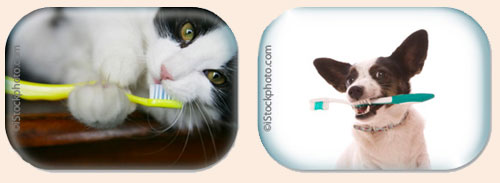Many pet owners are aware that their dog or cat has bad breath or halitosis. What they may not know is that bad breath is an indication that something more serious is going on in their pet’s mouth.

Studies indicate that approximately 85% of cats and dogs over the age of 3 years have some form of periodontal or dental disease. Like people, pets accumulate plaque on a daily basis. Plaque is composed of 90% microscopic bacteria that, over time, harden and become tartar or calculus. These bacteria and tartar can lead to gingivitis (gum inflammation), which is the body’s response to the unhealthy bacteria.
When the gum tissue is unhealthy, it often progresses to periodontal disease, which causes bone loss at the root of the tooth and then tooth loss.
At San Bruno Pet Hospital, we believe that one of the most important parts of pets’ health care is attention to dental disease.”
Regular teeth brushing at home can greatly improve oral health, and thus overall health, and help reduce or prevent periodontal disease. However, a big part of oral care is educating clients about preventive care at home in addition to routine dental procedures, which include teeth cleaning, charting and full-mouth radiographs at your veterinary hospital.
A comprehensive dental cleaning should include scaling of each tooth both above and below the gum line, thorough evaluation of each tooth, measuring any gum recession, and taking radiographs to detect the cause of any deep pocket or loose tooth.
Once all disease is addressed, the cleaning should be followed by a high-speed polishing to help fill the small grooves created in the enamel by cleaning and normal wear.
General anesthesia is required in order to clean below the gum line, to obtain radiographs, and to prevent the pet from aspirating bacteria and debris being removed.
It is important to recognize we can only see a portion of each tooth because less than half of the tooth, which comprises the crown, is exposed. The roots of each tooth below the gum tissue can hide advanced disease very well. The analogy of the “the tip of the iceberg” applies here.
Our pets age quickly, and build-up of bacteria and germs can have an adverse effect on their health. Poor oral hygiene affects more than just the mouth; infection in the mouth enters the bloodstream and often causes early kidney disease, and it can even damage heart valves.
Infected teeth and gums are also painful. The majority of pets continue to eat and drink even though they may have severe dental disease; thus, appetite is not always a good indicator of a problem.
Preventing disease is our ultimate goal, so educating our clients on things they can do between dental cleanings is an important part of our practice. We create a customized plan of prevention and care for each patient and include recommendations for foods, treats and toys that help make home care easier and more fun.
By Deanne Bonner, RVT, and Terri Johnson, CVT

